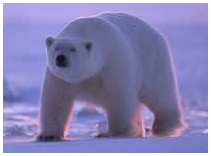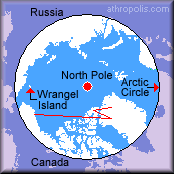
 Roam, Roam on the Range Polar bears were once thought to be aimless wanderers, but scientists now believe that, like other members of the bear family, many of them have distinct territories, or home ranges. After leaving their mothers, young polar bears may travel more than 1,000 kilometers / 600 miles to establish their own territory.
It appears that the size of a polar bear's range is determined by the amount of available food. Bears living in areas with an abundance of ice and seals have smaller home ranges.
A satellite-tracked polar bear surprised researchers with a 3,000 mile / 4,800 km trek. Starting at Prudhoe Bay in Alaska, she traveled across the top of the world to Greenland (See red line on map). She spent the winter there before moving on to Canada's Ellesmere Island and then back to Greenland again. (There must've been slim pickin's in that range.) Wrangel Island is well known for its large concentrations of polar bears, and it has therefore become a key location for research. Keeping track of the bears' whereabouts is very important because of the threats they face, including climate change, pollution, and poaching.
Click pictures for more information and credits. Library: Polar Bears, Animals Environment, Arctic Links: Animals, Arctic News Story: Warning Signs in the Arctic Arctic Maps & Weather Reports |

|
DICTIONARY: Just "double-click" any unlinked word on this page for the definition from Merriam-Webster's Student Electronic Dictionary at Word Central. |

|
ARCTIC LIBRARY & GLOSSARY: Check this section for an index of the rest of the things you really need to know about the Arctic. |

|
ARCTIC MAPS & WEATHER REPORTS: Maps of the Northwest Passage, explorers' routes, iceberg sources, Nunavut, the Arctic by treeline, temperature... |

|
ARCTIC LINKS: Even more information! Links to sites related to the Arctic and "Iceberg: the Story of the Throps and the Squallhoots". |

|
GUIDE TO ARCTIC SUNRISE & SUNSET: How much sunlight or darkness is there in the Arctic on each day of the year? |
to is the property of their respective owners, and Athropolis is not responsible for their content.
